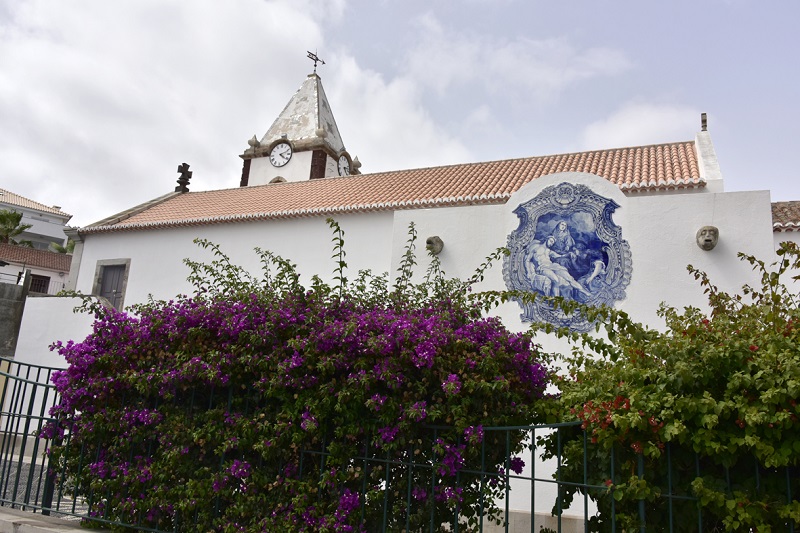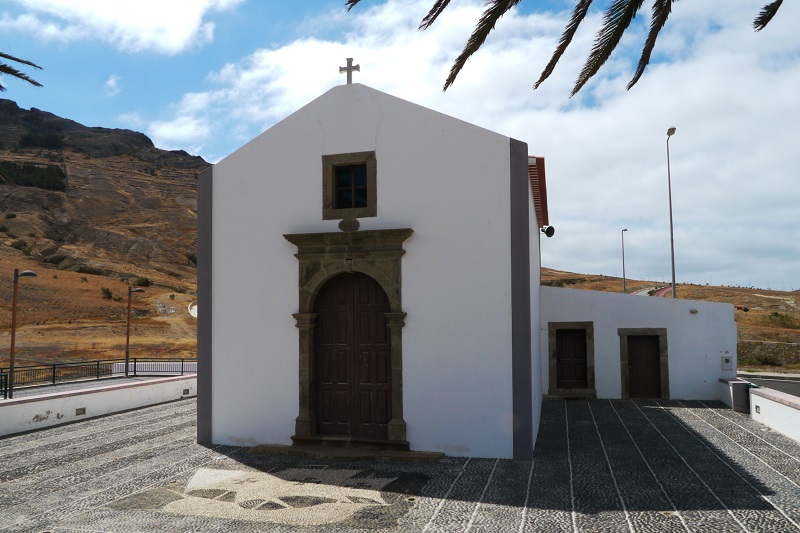THE CHURCH OF OUR LADY OF PIETY – MAIN CHURCH OF PORTO SANTO
Of mannerist features, although it also has baroque and rocaille lines, this church has been classified as Landed Property of Municipal Interest and possesses an interesting collection of paintings, sculptures and jewellery. The primitive church of the XV century, was built by Infante D Henrique, but was reconstructed in 1667 due to a fire. The main altar has a wooden retable, of mannerist features, of the XVII century, of regional work. On this altar there is a painting of “Our Lady of Piety”, by the Portuguese proto-baroque painter, Martim Conrado, partner of the Royal Painter Avelar Rebelo (c. 1600-1657). There are two more paintings on the altar, representing “Joseph of Arimathea” and “Nicodemus”, signed by Max Römer (1878 – 1960). The collateral retables date back to the XVII century, and have, on the Gospel side, on the altar of the Heart of Jesus, two small paintings of the XVI century– “Eternal Father” and “Beheading of São Brás (?)”. There is also, an image of “Our Lady” of the XVI century, traditionally called Our Lady of Expectation on painted, gilded and polychrome wood of Flemish work. In one of the chapels of the church there is an oil on canvas painting, “Noli me tangere”, signed in 1653 by Martim Conrado, indicative of the proto-baroque language through games of light and tenebrist language. In this church there are also tiles from the XVII century, of polychromatic patterns in the spires of the tower, which were recovered during an artwork campaign and placed there in 1899. Under the guardianship of the church factory there is a broken up carved retable, possibly of the XVI century or the beginning of the XVII century. The sculptural set of the “Last Supper” made in polychrome, gilded wood of the XVII century and of regional work, is also very interesting. Also worthy of note is the collection of silver objects from the XVII, XVIII and XIX centuries (incense boat, monstrance, safe) and the tile panel – “Our Lady of Piety” (XX century), a gift from D. Laura Gilbert and her husband, benefactors of the Main Church of Porto Santo, and owners of the Factory of Sacavém. In this church some regional materials such as the white masonry of Porto Santo can be identified, among others. This church has been subject to several pirate and corsair raids, in 1566 (French, commanded by Montluc), 1617 and 1667 (Algerians) and in 1708 (the English, commandeered by Captain Amias Preston).
THE CHAPEL OF THE HOLY SPIRIT
The Chapel of the Holy Spirit, situated in Campo de Baixo, is in the middle of a residential area. Originating from a XVI century chapel, it underwent remodelling or rebuilding in the XVII and XVIII centuries. The most significant intervention happened in 1793 at the behest of the then administrator Captain Sebastião António Drummond, the construction work went on until 1819, at which time permission for the blessing of the chapel was requested. This campaign of work resulted in the holy water font built in Porto Santo stone, resembling a shell, segmented inside and out, mounted onto the wall. There is a XVII century retable, built between 1650 and 1670 attributed to the Madeiran sculptor Manuel Pereira, active from 1624 to 1679, or to a follower of his models, like his nephew, the carver Manuel Pereira de Almeida, active from 1677 – 1720/1730. But it is the painting of “Sacred Family” and the polychrome retable of gilded wood that bear witness to the existence of a primitive chapel of the XVI century and a campaign of work in the XVII century, they are two crucial pieces of the devotional and artistic heritage of this chapel and the island of Porto Santo, an oil on wood painting of the XVI century, circa 1530, of Flemish work (Antwerp) close to the circles of Joos van Clève (1485-1541) or Quentin Metsys (1466-1530).
THE CHAPEL OF SAINT PETER
Small, located on the slope of Pico de Ana Ferreira, the Chapel of Saint Peter, also classified as a Landed Property of Municipal Interest, is a XVII century construction with significant work done in the XVIII century; the altarpiece is from the late seven hundreds. That is why its typology is integrated in a mannerist and baroque manner, on a longitudinal plan, with a single nave and a lower chancel. The façade forms a gable roof with a cross and a full arch portico, in grey stonework, with a straight and protruding cornice with impost, over which there is a window framed in grey stonework. In the interior we notice the ceiling of the chancel, painted and bearing the emblems of Saint Peter, angels and vegetal elements. The pulpit, a cubic box, common in the XVIII and XIX centuries, shows rocaille paintwork, of regional work. What stands out most is the baroque, gilded polychrome altar-piece. In the alcoves there are three images from the XVIII century, painted on polychrome, gilded wood, highlighting two great works: “Saint Peter”, glistening with silver, of large dimensions, doing justice to the chapel organ, and “Saint Peter Xavier”, the apostle from the Orient, and a “Saint Anthony” of a more popular work. Next to the sacristy, there is a holy water font in carved stonework, with shells from the island. Outside, the churchyard is paved with pebbles, with a design of the figure of a caravel, as a reference to the guardian saint of navigators.
THE CHAPEL OF OUR LADY OF GRACE
A place of pilgrimages since ancient times, this rural hermitage is situated in Casinhas. The precise date of construction is unknown due to the theft of Porto Santo books and archives by pirates. However, inside there is an image of “Our Lady of Grace”, a Flemish, sixteenth century work in painted, polychrome, gilded wood, detailed by Gaspar Frutuoso in 1583, estimating 1813 to be the last date of reconstruction.
THE CHAPEL OF MERCY
There is information on the Chapel of Mercy from 1605, but its construction dates to the XVI century in the wake of the foundations of the Misericórdias (a charity foundation) and their importance with the communities. There is an inventory dated to 1732 that attests to the heritage wealth of the Misericórdia (charity) of Porto Santo, with a list of crucifixes, chalices, candlesticks, crosses, retables, and fronts. In 1793, the properties of the Misericórdia were inventoried, because it received other assets besides the pious legacies. The chapel of Mercy is of mannerist lines, on a longitudinal plan and a single nave, with a lower and narrower chancel. In the interior there is a rococo style retable with marbled surfaces and columns, using a technique in plaster. A retable finished in a rocaille palette, structured in two pairs of columns and a cropped attic. In the centre there is a painting, “Visitation” and some devotional images. It is illuminated by slatted windows. The triumphal arch shows a keystone carved with the instruments of Passion. The portal is a round arch with protruding cornice, straight, over which there is a rectangular window, framed in grey stonework and topped by the national arms carved in stone. It is finished by a gable roof with a cross. Attached to the chapel is the building where the Misericórdia was run.
THE CHAPEL OF SAINT CATHERINE
The chapel of Saint Catherine is situated within a cemetery and is a reconstruction of the XIX century, with construction work documented in 1838, followed by other work done later. However, in the portal, typically gothic pillars and chapiters can be observed, built in red stonework that must be from the primitive construction, as a base for the diamond point pillars, chapiters decorated with protruding spheres. The portal is a full arch, built in grey stonework topped by an impost, and overshadowed by a circular spyglass. Inside, there is a simple, wooden altar with small gilded features and marbled effects, following the plasterwork technique. Access to the chapel is through a forested avenue, with pebbled flooring in geometric designs. It is important to note the use of Porto Santo stonework, as well as other materials.








